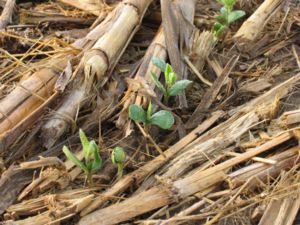No-till agriculture increases crop yields and environmental gains
Despite the environmental benefits of no-till agriculture, farmers often hesitate to change to this management approach due to uncertain economic returns.
Sarah Cusser, postdoctoral research associate at the Kellogg Biological Station (KBS), and MSU terrestrial ecologist Nick Haddad, director of the Long-term Ecological Research (LTER) program at the Kellogg Biological Station (KBS) and professor in the Department of Integrative Biology and the Ecology, Evolution, and Behavior Program, however, have just published a study in Global Change Biology that clearly demonstrates significant benefit to both the environment and to crop yield for farmers practicing no-till versus tilled agriculture consistently over many years.

Additionally, Haddad's and Cusser's work demonstrates the importance of long-term research for obtaining meaningful results, especially on the outcomes of management changes that can be slow to develop and to detect, such as the attributes of cropping systems on soil structure and organic matter. Unquestionably, studies of shorter duration than theirs would have produced misleading results.
"The findings drive home the importance of long-term studies because they reveal unexpected results," Haddad said. "The typical duration for a grant is maybe five years. Our study shows that research of such short duration may be misleading. Certainly, for this study, there were many slices of time when we would have gotten the wrong answer, especially if the study had lasted less than 10 years."
Using data from the KBS LTER program that began in 1989 to study how land use intensity affects agriculture and environment, Cusser, Haddad and colleagues explored the long-term agricultural and environmental effects of converting agriculture management practices from tilled to no-till.
"Every year for more than 30 years, the yield in no-till treatments increased versus the yield in tilled treatments - every year," Haddad noted. "I would have expected a point where the yields and economic benefits reached their peak, but they continued to rise. It was jaw dropping."
Based on assumptions about the financial investment required in converting from conventional tilling to no-till agricultural practices at the study's onset, overall farmer profits were initially reduced, despite the increase in actual crop yields in no-till fields each year.
"The initial economic losses reflected the costs inherent in new equipment, chemical costs and labor input needed at that time," Haddad said. "As these costs were met, profits rose. Even better, current farming practices eliminate these costs, such that the financial benefits of no-till practices accrue nearly immediately."



